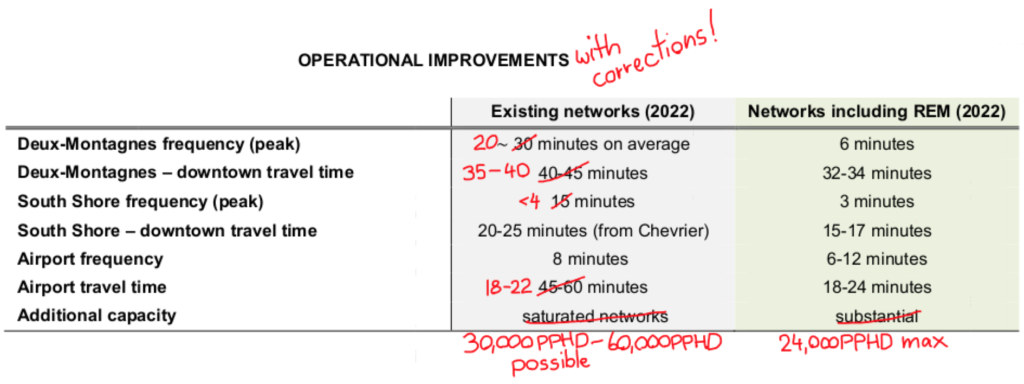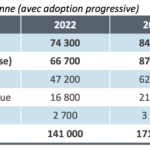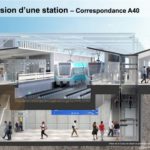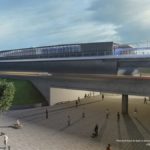The CDPQ and Bill 137:Constructing Alternate Realities
May 23rd, 2017 by ant6nIt’s been quite a while since I wrote about the REM, Montreal’s controversial light rail project. Since my last analysis on the subject, I spent more time following the official channels to try to participate in the discussion — I submitted a 100 page brief and a 20 minute presentation at the independent environmental consultations office to try to improve the project and point out problems.
The final BAPE report, generally warned of the many issues that I have also discussed on this blog, and indicated they could not recommend this project to go forward at this time.
One thing that the BAPE criticized was the lack of information regarding the financing of the project, especially the operating costs. So shortly after, CDPQInfra released a Note on the financing that does include a few numbers on the operating cost, mostly trying to show that the it will not be larger than for the existing public transit system, even though the REM will have to pay off the capital costs and the rather large 8% return demanded by the Caisse.
Most of their document is concerned with trying to prove that the existing transit system is basically crap and that the REM is the only way to fix that, and that the REM will be much better than the current network.
I’ve become weary of the proclamations by CDPQInfra, I’ve previously written about how they like to cook numbers and distort facts in order to make their projects appear great while dismissing criticism. They’ve made claims that later turned out to be half-true or not true, or true only from their own narrow point of view.
For example the claim that “transit would be profitable†turned out to be that “transit would be profitable for the Caisse, as long as the public pays a large number of subsidiesâ€. Or the claim that “there would be no shut-downs of the Deux-Montagnes line, except may for a weekend or two†turned out to mean “we will single-track the whole line and only offer some rush-hour service in one directionâ€. They also keep referring to their project as a public-public partnership, when it is actually a full-on privatization project.
The “Financing Note†for the REM
What struck me in this “Financing Note†document is that they even misrepresent facts that can easily be verified, numbers that we can just look up.
Case in point, the following table from their document, which I helpfully annotated with some corrected numbers:
Let’s go through some of these numbers.
Note that the “Existing Networks†is labelled with “(2022)â€, meaning that we should also take into account the improvements that were planned on the network before the REM was announced.
1) “Deux-Montagnes frequency (peak): ~30 minutes on averageâ€
If we look at the actual schedule (link) during the peak hour, we see that the departures are actually 20 minutes apart (4 departures between 6:35 and 7:37, and 4 departures between 16:30 and 17:25).
Furthermore, the AMT has recently done some upgrades to allow running their heavy dual-mode engines and multi-level passenger cars on the line, which could allow increasing the service. The AMT capital budget for years has shown an unfunded project to increase double-tracking on the line, an item costing a mere 50M$, which would also allow increasing peak service substantially – and it could easily be implemented by 2022.
2) “Deux-Montagnes – Downtown Travel time: 40-45 minutesâ€
A quick look at the schedule finds that the travel time is actually 35-40 minutes. CDPQInfra simply adds 5 minutes of travel time to make their project look better.
3) “South Shore Frequency (peak): 15 minutesâ€
Looking at the actual schedules, we find that Terminus Chevrier is served by the 90, during the peak, every 3min-5min, with some departures only 2 minutes apart.
Terminus Panama is served by the 45 bus shuttling downtown. During the peak it runs less often, in the 8min-10min range. But also during the peak, 20-30 bus lines that generally terminate at Panama are through-routed to downtown, most stop at Panama. The Transit App trip planner tells me there are departures every 1min-4min.
4) “Airport Travel Time: 45-60 minutesâ€
To get to the airport by transit, you have to take the 747 express bus. This bus stops at two large metro stations (Berri-Uqam, Lionel-Groulx) and at various places in-between that connect pretty well to several downtown hotels. Generally, most people come from the metro system, and most connect at Lionel-Groulx.
During my last couple of trips to the airport, I have measured the bus travel time from Lionel-Groulx to be around 20 minutes. Indeed, the scheduled time is around 18-22 minutes, increasing to about 28 minutes in the rush hour direction. Once the construction around the Turcot highway interchange and the Dorval circle is finished by 2022, the bus will run on dedicated lanes — which should bring the travel times to 18-22 minutes at all times.
5) “Additional Capacity: Saturated Networksâ€
This claim is the most egregious. It basically comes down to claiming that if the REM is not implemented, there could be no improvements to the existing networks. Even though there are current projects in the pipeline to increase service (like the previously mentioned 50M$ double-tracking project of the Deux-Montagnes line). There are ways to add capacity for much cheaper than the complete rebuild that the REM proposes.
Overall, the theoretical capacity of the existing heavy rail network is much higher than today. It’s possible to triple the capacity with some investment — as for example proposed in the 2007 AMT study to place stations at Edouard-Montpetit, which assumed 5 minute frequencies in the tunnel.
Beyond that, there do exist North American heavy rail lines that allow 120 second frequencies – for example the North River tunnels in New York City. If similarly advanced signalling and emergency measures were implemented in the Mount-Royal tunnel, it would essentially six-tuple its capacity compared to today.
The REM would run at 150 second frequencies from the beginning — very close to the claimed maximum theoretical frequency of 90 seconds. Assuming this is actually possible, this would mean the absolute maximum theoretical capacity is only about 66% higher than the initial capacity — really much less room to grow.
And this absolute maximum theoretical capacity of the REM (24,000 PPHD) is still less than upgrading the existing heavy rail system to 120 second frequencies (60,000 PPHD).
So the claim that additional capacity opportunities are “substantial†for the REM, while the existing networks are “saturated†is simply not true.
CDPQInfra: A company of Spin and PR
Just taking a closer look at the above table, it’s easy to see that the CDPQInfra relies on simply printing false numbers in their pronouncements. They have trouble being honest. Whatever they say should be questioned vigorously, especially by journalists repeating those press releases. For a company that claims to be public (which isn’t actually true either), it is probably one of the least trustable.
Within this context, their first reaction after the release of the BAPE report is rather ironic: CDPQInfra came back blasting the whole BAPE process right away, in a press release titled “BAPE report on the REM project: An analysis that overlooks facts and distorts realityâ€. “Distort realityâ€, that’s pretty rich.
A similar thing happened when journalist Francis Villes form La Presse crunched some numbers that indicate that the operation of the line will cost the public a lot of money every year in order to ensure the profitability to the CDPQ. When he asked CDPQInfra for comment, their spokesperson responded with the following:
“Le REM offrira un service de qualité et à haute fréquence, qui promet de transformer la mobilité dans la région et d’améliorer la performance du transport collectif. Et ce, au même niveau de coût par passager-kilomètre que les réseaux actuels. Pour des revenus par passager-kilomètre équivalents à ceux des réseaux actuels, le REM couvrira non seulement ses frais d’exploitation, mais également les coûts d’immobilisation, ce qui démontre la très grande efficacité du modèle d’affaires. Prétendre le contraire revient à induire le public en erreur.â€
Effectively he’s again repeating this will be a great project, and it will supposedly cost the public the same in subsidies as the current public transit system — and to be pretending otherwise would be to “mislead the publicâ€.
It’s the pot calling the kettle black.
Enter Bill 137
This brings us to bill 137. It’s a rather concerning development, a bill proposed by the government of Quebec to fast-track the REM project.
The bill
- Disallows those being expropriated from contesting the expropriation.
- It exempts the REM from municipal taxes.
- It simply declares that the REM will be deemed in compliance with the BAPE.
- It overrides the act respecting the preservation of agricultural land allowing the REM to convert a bunch of agricultural land.
- It stipulates that the ARTM (the AMT replacement) will have to transfer 512M$ to the REM project “in lieu of land value capture†(receiving no equity in return).
- It forces the ARTM to enter into an agreement with the REM for the ongoing financing of the REM — and if the ARTM doesn’t do it, the minister can just decide the terms of the agreement.
- It gives servitudes to public roads in order to build the REM.
This is basically a law that that overrides existing rules and gives powers, large amounts of subsidies and resources to a private company that will privatize essential transit assets, move it out of public control, and extract large amounts of money from the public to run it.
And just like CDPQInfra keeps trying to construct an alternate reality to advance their project, the government is constructing an alternate reality where the REM doesn’t break the rules of the environmental consultation process and the preservation of agricultural land.
My trust in this company is rather low at this point, but apparently the Liberal government trusts it more than actual public agencies.
I look at this with concern and agree with UdeM urbanism professor Gérard Beaudet, who calls the REM the creation of a “Barony in the heart of the Metropolisâ€.




May 25th, 2017 at 23:25
Hey!
I don’t want to download every link on http:/www.bape.gouv.qc.ca/sections/mandats/Reseau_electrique_métropolitain/index.htm to figure out which is yours, do you know off hand which link it is so I could download and watch it? I love your work and keep up the good stuff
May 30th, 2017 at 18:01
My brief.
(one could also find them by searching for my name on the list of memoirs)
May 31st, 2017 at 13:58
I spoke to a colleague of mine who is working with Metrolinx and GO Transit on their RER Program (Regional Express Rail). This program will to be completed by 2025, will electrify 4 of the 7 GO Train Lines add a massive amount of capacity by upgrading many single track routes into double track ones, vastly improve the signaling along the lines as well as electrify them up to the maximum mileage point that GO transit’s ownership allows them to do. This will allow on the core part of the GO Train network to operate trains every 15 minutes all day in both directions. The other 3 lines will also have their frequencies massively updated as well. Beyond the end of the electrified portions of the 4 GO Train lines, increased diesel train frequency will allow at least 1 train per hour all day in both directions. The construction on certain lines began as early as 2014. The first pieces of heavy construction started last year on the Barrie GO (adding a second track) and Stouffville GO Lines (multiple road overpasses and the initial work of adding a second track for a significant portion of the line). This whole program is going to cost $13.5 Billion.
With all of this, my colleague still is racking his brain as to why, with all the work done on your Mascouche Line and a pre existing electric commuter rail line that you already own, a line that has already a significant amount of double tracking, has what would be presently an almost impossible to build, pre existing double track heavy railway tunnel going directly into downtown leading to a well connected existing downtown railway station, why would you get rid of this and build a Light Metro System (this is not real LRT in any way) which is clearly just reinventing the wheel and which clearly has less passenger carrying capacity than what you already have! For god’s sake why? Your downtown railway station which unlike Toronto’s Union Station, still has a lot of excess passenger carrying capacity and could easily accept continuing improvements for some time, long before you would have to pay for upgrades to it.
If you build this 67 km driverless Light Metro system you will still have to hire a significant number of legally required “Attendants” who respond to problems on board the trains, instead of employing “drivers”. Just ask Translink in Vancouver how much money your Attendants really save instead of just employing a driver on each train, especially as the network gets bigger.